[From the archives: Today (September 23rd) is the first day of the fall o-higan (お彼岸), when ohagi or botamochi are offered to ones ancestors, as well as oneself! My mother and my grandmother always made these at home around this time of year - I love their not-too-sweet stickiness. O-higan ends on the 26th, so if you like wagashi, why not give these a try? Originally published March 2007.]
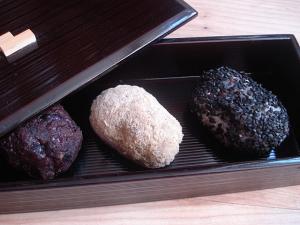 The seven days centered around the bi-annual days of the vernal equinox is a Buddhist festival period known as higan (or o-higan for the honorific term) in Japan. The fall (autumn) higan is aki no higan, and the spring higan is haru no higan. Since the day of the spring equinox is March 21, we're about to enter the haru no ohigan period.
The seven days centered around the bi-annual days of the vernal equinox is a Buddhist festival period known as higan (or o-higan for the honorific term) in Japan. The fall (autumn) higan is aki no higan, and the spring higan is haru no higan. Since the day of the spring equinox is March 21, we're about to enter the haru no ohigan period.
During haru no higan, a sweet confection called botamochi is eaten. The mochi part means sticky, pounded rice, and the bota part comes from botan, or the tree peony. Botamochi is supposed to ressemble a tree peony flower.
During the autumn equinox (aki no higan or simply (o)higan)) period, a very similar confection called ohagi is eaten. This is supposed to look like a hagi or bush clover flower (Latin: Lespedeza thunbergii). Botamochi and o-hagi look the same to me, even though a hagi flower looks nothing like a tree peony flower, but the good old ancestors were probably a lot more imaginative than I am.
Botamochi and o-hagi are made of sticky rice and sweet tsubuan, 'chunky-style' sweet azuki bean paste. They are a bit fiddly to make but not difficult, especially if you use one of my favorite cooking helpers, plastic cling film. Since these are best eaten freshly made, it's well worth the effort to make them at home if you like bean-based Japanese sweets. You can adjust the amount of sugar in the tsubuan to your taste. Here I have made three variations: coated with black sesame seeds; coated with kinako (toasted soy bean powder); and the most traditional form with the rice cake wrapped in a layer of the tsubuan.
Filed under:
dessert japanese legumes rice vegetarian sweet vegan gluten-free wagashi
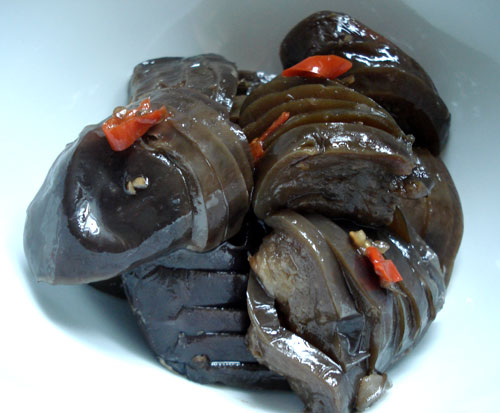
It's hard to take an appetizing picture of this eggplant (aubergine) dish. But I promise you that it's absolutely delicious. Plus, it's so simple to make, requiring just 6 ingredients and water.
I found it in an old Japanese cooking magazine, which had an even worse photo of the dish than the one here. I was a bit sceptical but had bought a too-big batch of eggplant at the market, and wanted a way to use some of them up. I am so glad I tried the recipe, because it's now one of my favorite ways to have eggplant. And it's vegan too.
There's a saying in Japanese, akinasu yome ni kuwasuna (秋なす 嫁に食わすな). It means "Don't let your daughter in law eat fall eggplants". People debate what the intent of this saying is; does it mean that fall eggplant are too delicious to feed to the daughter in law, who was traditionally the lowliest member of the family? Or perhaps it's a thought of kindness, since eggplant is supposed to be a 'cooling' vegetable, which is not good for a pregnant or fertile young woman. Either way, there's no doubt that eggplant is particularily delicious in late summer to early fall, when they usually produce a second crop after a first one early on.
Filed under:
japanese vegetables vegetarian favorites vegan
[From the archives: This eggplant/aubergine dish is really nice served cold, though it can be served warm too. It doesn't heat up the kitchen since it's made in the microwave (yes, the microwave, and it works great!) so it's great to make on a steamy hot summer evening, with in-season eggplant. Originally published July 2007.]
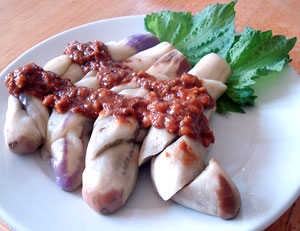
Here is another summer dish. I love eggplants (aubergines), but cooking them without using a lot of oil can be a bit tricky. I read about this method of steam-cooking eggplants in the microwave in a Japanese magazine some time ago, and ever since it's one of my favorite ways of preparing these rather spongy vegetables - they're done in just 5 minutes without heating up the kitchen, which is hard to beat on a hot summer's day. The whole dish takes less than 10 minutes to prepare.
Here they are served cold with a spicy peanut sauce, which makes it a very nice vegetarian/vegan main dish. Serve with rice or cold noodles.
Filed under:
japanese lighter vegetarian summer vegan
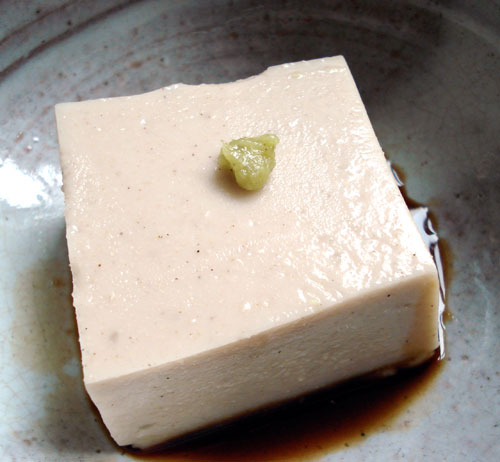
There are some dishes in Japan that look and have a texture like tofu, but are not tofu in the traditional sense; that is, they're not made from coagulated soy milk. One of these not-tofu tofus is goma dofu (ごま豆腐)or sesame tofu. Goma dofu is made from three simple ingredients: ground sesame paste, water, and kuzu or kudzu powder.
Filed under:
japanese vegetarian vegan gluten-free
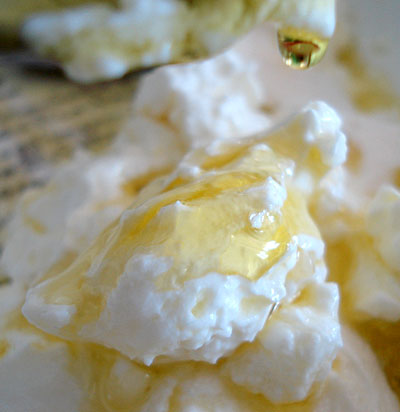
Hugh Fearnley-Whittingstall has an article about how to make yogurt (or as they spell it in the UK, yoghurt) in the Guardian. I did not want to go to the trouble of making yogurt from scratch, but I had a big pot of plain yogurt that needed to be used up so I made a sort of variation on the yogurt cheese balls further down on the page.
Yogurt cheese, in case you are unfamiliar with it, is just plain yogurt that has been drained of much of its liquid. To make it, just line a sieve with some porous cloth like cheesecloth, muslin, a coffee filter or even a couple of paper towels, spoon the yogurt in, and put the sieve with a bowl underneath in the refrigerator for at least a few hours. The more you let it sit, the drier it will become.
I strained about 2 1/2 cups of yogurt mixed with 1 teaspoon of sea salt from Friday evening to Sunday morning, by which time it had become the consistency of whipped cream cheese. I put this into a bowl, grated one garlic clove over it and drizzled on some extra virgin olive oil and mixed it up. It was the perfect spread for freshly baked hot savory scones.
I've never been a big fan of very sweet yogurt, so this savory yogurt spread may make more breakfast appearances.
Filed under:
breakfast party food dairy vegetarian
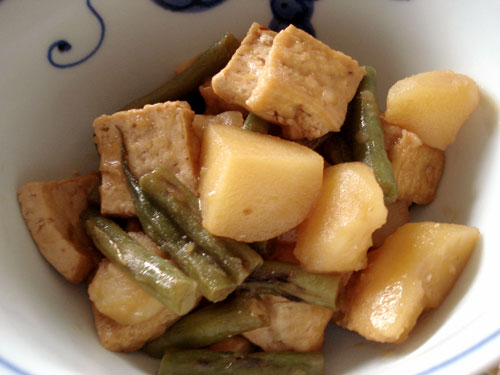
_Nikujaga_, stewed potatoes with meat, is a staple of Japanese home cooking. It's filling and comforting, and appears quite frequently for dinner at our house. Recently though I've been making this vegan version more frequently, which is just as tasty as the meaty version. Thick fried tofu (atsuage) is the protein replacement, but it's not just there for it's nutritional benefits - I love the texture in a lot of dishes.
The recipe, plus some ideas on how to reform Japanese non-vegan recipes to make them vegan, after the jump.
Filed under:
japanese potatoes vegetarian favorites vegan
More and more these days I'm getting requests for vegan and vegetarian recipes. While I'm not a vegetarian as I've stated here before, I like to eat a daily menu that's light on meat, and am always interested in vegan and vegetarian protein options.
There are several what I'd call factory-manufactured vegan protein products out there, from TVP to quorn. I'm sure they are safe and wholesome to eat, but I'm more interested in traditional, or time-tested, vegan/vegetarian protein alternatives.
This is the list I've come up with so far. They are Japanese-centric, since that's what I'm most familiar with. Do you have any others to add?
Filed under:
japanese ingredients vegetarian vegan
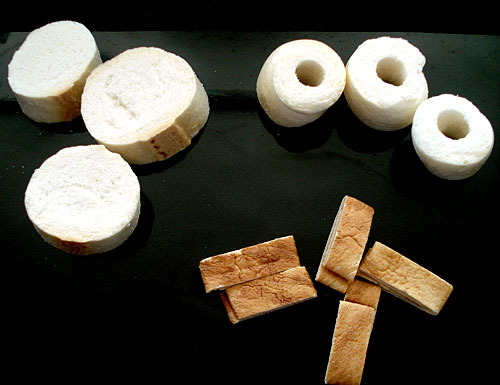
Vegetarians are probably familiar with seitan as a meat substitute. Seitan is wheat gluten that has been kneaded in such a way that the gluten threads align themselves to resemble meat. It was invented by advocates of the macrobiotic food movement in Japan, specifically as a meat substitute, in the 1960s. (Fairly accurate (from what I've read elsewhere) Wikipedia entry.)
But way before there was a macrobiotic movement, let alone seitan, people in Japan were already eating a wheat protein product called fu (麩). Like seitan, fu is made from the gluten that is extracted from wheat flour. Sometimes the gluten is mixed with other ingredients. There are two kinds of fu: raw (namafu 生麩), which is basically fresh fu; and grilled and dried (yakifu or yakibu 焼き麩). Here I'd like to focus on the dried kind which is much easier to get a hold of for people outside of Japan. It's also a great pantry item, since it keeps for a long time.
Filed under:
japanese ingredients vegetarian vegan
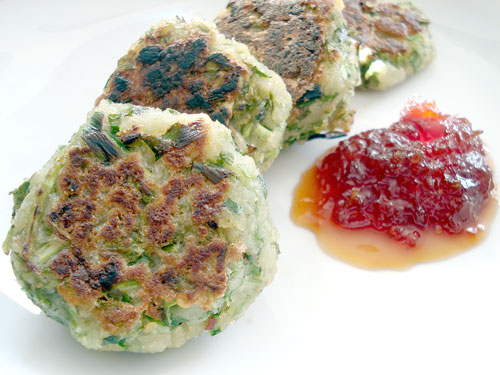
These tasty little savory cakes are made of ground lotus root. The texture is quite surprising - almost like mochi cakes. It's a great vegan, gluten-free savory snack that's high in fiber and packed with flavor.
Filed under:
party food vegetables vegetarian vegan gluten-free asian
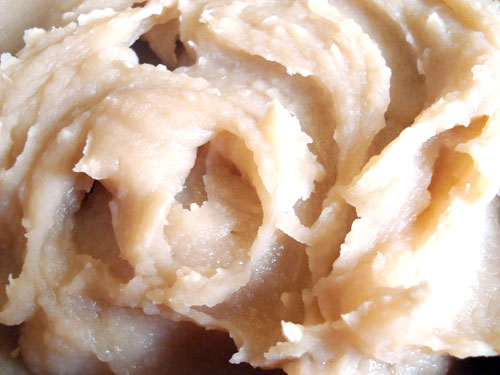
Usually when I put a recipe up here, it's something that's been fully resolved: that is, I've tried it out for myself (in most cases several times over), and I know that it works. This one is a bit different, but I thought I'd write about it in-progress, as it were, anyway.
Filed under:
legumes vegetarian vegan
Pages